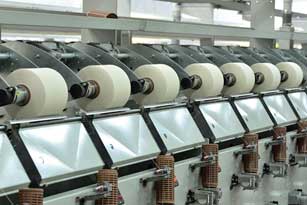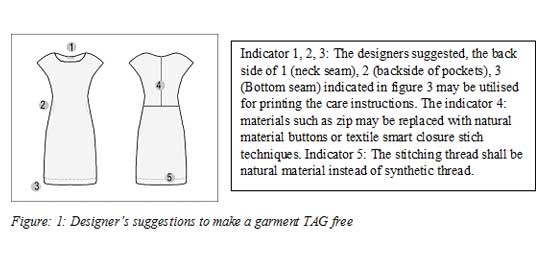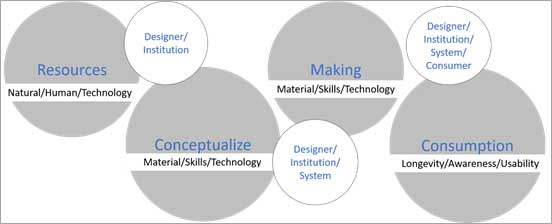
Slow fashion in India: Narratives from emerging textile designers
Prof Dr Kislaya Choudhary shares how designers today are emphasising the importance of slow fashion and sustainability.
Fashion is ubiquitous and it marks its presence in everything that we express and endorse. Fashion is not limited to clothing, accessories, and self-identity; it has extended itself to our surroundings and environment too. The tools, techniques, and technological evolution have pushed the boundaries of democratic fashion by incorporating sustainable ways of making Fashion. The questions around sustainability revolve significantly around the way we consume and also the way we conceptualise. There is a need to reflect on the creative conceptualisation strategies and integrated makers space for endorsement of the slow-fashion movement and human-centric design for fashion. Most of the need for fashion is designed strategically and would not have existed if we decided to reimagine the designing and making process.
It’s evident that fashion makers define the need and aspirations for people rather than people deciding for themselves. Slow fashion is a step towards sustainability that provides insights by reimagining the work culture and fashion stakeholders. It encourages the retailers and consumers to be conscious of the making and buying decisions. In slow-fashion, major focus has always been on manufacturing and buying, however, designers have the larger potential to play a significant role by strategically conceptualising the fashion considering people, planet and profit. While the industrial practices continue to accelerate, the moment of pause to reimagine fashion can be shaped up significantly by the designers who are the primary stakeholders in creating fashion.
Here is the responses and strategies adapted by young Indian designers from NIFT for making fashion a choice that is ethical, collaborative, engaging, and meaningful for a sustainable future. The narration has been developed based on deliberations with NIFT Alumni, young Indian designers, start-up founders, up-and-coming entrepreneurs, fashion makers endorsing the values of slow fashion and sustainability.
Background

The fast fashion systems differentiate from the slow fashion in terms of appropriation of resource utilisation, conscious consumption and decrease of waste. Thus, slow fashion can create incremental impact on the regeneration of natural resources for regaining balance in a contemporary world (Honoré 2004). After the introduction of slow food movement in 2010 the “Slow Movement” was identified in other sectors such as Slow Design, Slow Fashion, Slow Production and Slow Retail etc. These movement inherited and shared similar goals and promoted deacceleration of the fast- paced processes. At the same time slow approach ensured a good quality of life for the people involved at every stage of making and buying (Fletcher 2007). “Slow fashion” term was coined by the researcher Dr Kate Fletcher. He was the first researcher who emphasised the similarities of slow fashion to eco, ethical and sustainable fashion (Fletcher 2008). Slow fashion is considered as a new model for social awareness, responsible production and conscious consumption (Fletcher 2008). In past few years, slow fashion has emerged as a more sustainable alternate for the fashion industry as a whole (Fletcher 2008).
Research Statement
While the industrial practices continue to accelerate, the moment of pause to reimagine fashion can be shaped up significantly by the designers who are the primary stakeholders in creating fashion. The designers hold an important space in the decision-making process by incorporating material and outcome of any product. Designers are a key member in decision making of the product packaging and design communication. The areas where designers may or may not get involve is the sourcing and distribution channels. However, with the rise in entrepreneurship and start-ups owned by designers the landscape of slow fashion has begun to change. This paper narrates the responses and strategies adapted by young Indian Designersfor making f ashion a choice that is ethical, collaborative, engaging and meaningful for a sustainable future.
Literature Review

Slow fashion stakeholders include everyone, starting from cultivator or raw materials to designers and users. The collective initiatives at every step of making and using becomes significant to the “slow fashion” statement. The various model often looked as in isolation forms the integrated umbrella of “slow fashion’ such as eco-fashion, ethical fashion, vintage clothing, second hand clothing, recycled fashion etc. (Cataldi, Dickson, Grover, 2010). The slow fashion is a combined view of making and consuming as a whole (Jung &Jin, 2014).
It is also discussed by European Environment agency that the circular economy is more supportive for the environment as the model of new system focuses on environment being a major concern (European Environment Agency, 2016). If we can focus on longevity and quality the lifespan and usability of a product can be enhanced. If maintenance and service systems are evolved parallelly the need to transform old into new will decrease. This shall slow-down the pressure on the extraction of natural resources (Murray et al, 2017).
In order to solve the issue further a new model was proposed and adapted for corporates was termed as the Circular Slow Fashion Model created by Skoog and Olsson (2018). This model incorporates principles of slow fashion and circular economy both. In order to make this model successful the designers and institutions need to work together. This model also stresses on (Ellen MacArthur Foundation, 2017), material longevity and product longevity (Goldsworthy, 2017) and suggests that these elements need to be integrated with slow fashion. Since this model focuses on the material itself therefore an institution level decision making plays an important role as stated by Skoog & Olsson, 2018.
In the recent times, NIFT has adapted various strategies to incorporate slow fashion concepts in academic deliverance and research endeavours. NIFT being a prime stakeholder in the Indian fashion industry has a high standing point in such initiatives. The curiosity to discuss and map the slow fashion model adapted by young designers forms the prime objective of this research. As one of the initiatives towards “slow fashion” the National Institute of Fashion Technology (NIFT) and the United Nations Environment Programme (UNEP) collaborated for course on design innovation for sustainable fashion across all campuses in India (Fibre to Fashion, 2021).
Method
The article narrates in brief about the strategies and efforts based on deliberations with Young Indian Designers, start-up founders, up-and-coming entrepreneurs, fashion makers endorsing the values of slow-fashion and sustainability.
Analysis
When we set out to explore the initiatives for “Slow Fashion” by young Indian designers; there is a lot we come across. Apart from brands and start-ups, we come across various design intervention and skill-based projects. However, there is no consolidated data available on this subject. A few start-ups by NIFT Alumni are; Yesha Sant, Fatimaradiowala, Kalanganhome, SagaJaipur, Myaara_withlove, PurukalStree Shakti, Surati-Varanasi from the field of Textile design. A few notable design studios endorsing sustainable practices where Indian young designers have consistently contributed are: Vraj Bhoomi, Pero, Huemn, Dvaa, Place the dot, Nishar Ahmed, Himbhoosha, Buna studio,Rias Jaipur.
As discussed with a few young Indian designer’s start-up owners about their understanding and association on slow fashion; various responses were received. The process of design begins with consideration about the resources and response from surroundings. The design process heavily leans on the available material in vicinity and the emerging mapping of user requirements. Therefore, procurement of material, skill and utilisation/integration of the right technology becomes an important decision. If the procurement slows down there would be instant impact on skilled human resources and nature. The designers also play an important role in the decision making regarding the presentation of design to consumer, such as packaging and visual merchandising/display.
Since slow fashion cannot be isolated as product making process and encompasses the makers and users both as an integral part of the eco-system therefore the presentation/communication of design to users can play a significant role to bring the change.“The Slow Fashion industry in India largely rely on local supplies and human resources as a conscious choice. Hopefully this is contributing to the “SlowFashion” as stated by one of the NIFTAlumni entrepreneur”.

Another important aspect discussed with entrepreneurs was; how do you see your involvement at each stage of making process and consumption? To these questions mixed responses were received. “Since we are the designers and the makers too. Therefore, our involvement at every step is crucial. We can choose our own brand image and endorse the values of slow fashion spontaneously. The issues surrounding making can be solved by adapting to new methods of localized sourcing, ensuring 100% natural material mix such as cotton yarn for stitching in place of polyester in cotton fabric, using coconut shell buttons or fabric handmade buttons in place of plastic buttons or metal zippers. Small details such as printing a block-printed logo and wash care instructions on inner seams in place of adding polyester labels and heavy tags can enhance the ease of recyclability”.
Findings & Discussions
The deliberations indicatefour major considerations for design adapted by the NIFT Alumni endorsing the principles of “Slow Fashion” in the Textile and Fashion industry. These indicators are; Resources, Conceptualisation, Making Process, Consumption.

The Alumni adds further; “often resources and making process is emphasised as a responsible element for the progression of slow fashion. However, today designers feel that conceptualisation is the key element. It can bring the maximum impact. The process of conceptualisation revolves around material, human resources, techniques, methods and even the longevity that impacts consumption directly. Conceptualisation process involves product design, material preferences, technique selection, sometimes production location (that depends on the technique selection), packaging and presentation. The slow fashion adaptation requires compact teams, working in complete harmony while crucial decision-making process. The start-ups usually have smaller teams focused to maintain the brand philosophy. The chances to overlook the loose ends can be effectively minimised. There is a flip side though, as most of these brands rely a lot on outsourcing the resources and production facilities, therefore it’s a very crucial and responsible task to keep quality check.
The post-Covid scenario creates a renewed level of awareness among people. The consumer may not care about a decorative packaging much while buying online. While gifting packaging may be addressed separately there is a need to look at how much non-sustainable material packaging design is required for online selling as most of these start up do not own any stores. Has the consciousness towards big brand logo and brand tags have changed? This query was answered by NIFT Alumni, “To some extent yes, we are still exploring though. To not imagine a tag and packaging is hard, however we may eliminate it completely or replace it with more sustainable solutions.”Based on these deliberations few workable solutions have emerged, however slow fashion endorsement is still fragmented and has a long way to go with conscious choices at each step of making. There is a need to integrate slow fashion principles at the design/product conceptualisation stage to visualize the possibilities.
About the author:
Prof Dr Kislaya Choudhary is professor and the Chairperson for Dept. of Textile Design, NIFT Mumbai. She is a PhD in design and specialises in textile design and creative design process. Her areas of exploration are; conventional and digitally printed textiles, computer aided design, interdisciplinary design research, contemporary craft practices & hybrid craft, visual research & design influence. She aspires to reinstate, moderate and innovate creative practices for endorsing a meaningful change.
References
Agency, European. Union, 2016. Circular economy in Europe – Developing the knowledge base, Luxembourg: Publications Office of the European Union.
Cataldi , C., Dickson , M. & Crystal , G., 2010. Slow Fashion: Tailoring a Strategic Approach towards Sustainability,. Karskrona, Blekinge Institute of Technology.
Fletcher, K., 2008. Sustainable Fashion and Textiles: Design Journeys, London: Earth Scan.
Foundation, E. M., 2017. A New textiles economy: Redesigning fashion’s future, s.l.: Ellen MacArthur Fundation.
Goldsworthy, K., 2017. The Speedcycle: a design-led framework for fast and slow circular fashion life cycles.. The Design Journal, Volume 20:sup1, S1960-S1970.
Honore, C., 2004. In praise of slowness, challenging the cult of speed, New York: Harper Collins Publishers.
Jung, S. & Jin, B., 2014. A Theoritical investigation of slow fashion: sustainable future of apparel industry. International Journal of Consumer Studies.
Murray, A., Skene, K. & Haynes, K., 2017. The Circular Economy: An Interdisciplinary Exploration of the Concept and Application in a Global Context. Journal of Business Ethics, 3(140).



